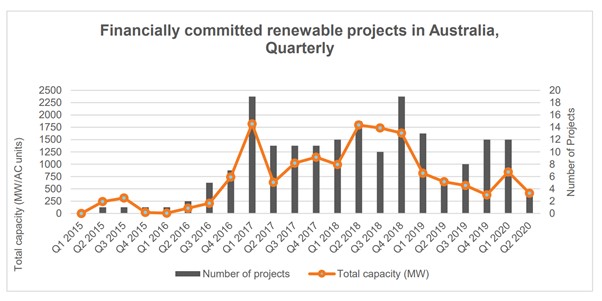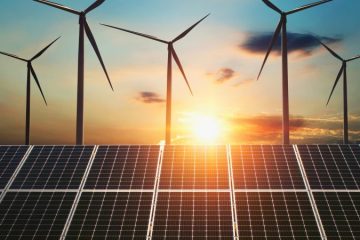Introduction
Australia’s main political parties are imploding over climate change policy, emission targets and the role of renewables. Political leaders of both persuasions have lost their jobs over this and before it is done and dusted, a few more will go. There is a reluctance by both political parties to firmly commit on the best way forward because they don’t want to offend one part of the electorate or the other.
Joel Fitzgibbon whose federal seat covers Hunter’s coal region is the latest to fall on his sword because he cannot commit to an ambitious mid-term target. Coal jobs are the sticking point and the value of exports they generate. Coal and gas exports reap a quarter of Australia’s export income.
Clean Energy Superpower
Economist Ross Garnaut says embracing low-carbon opportunities could lead to a clean electricity system more than three times the existing capacity that powers a transformed economy. A range of renewable energy projects are coming online that will give shape and meaning to what Garnaut described as Australia’s potential to be a clean energy superpower. No project provides greater meaning to this claim than Sun Cable’s ambitious $22Bn development of 15,000 hectares of solar panels in the Territory that will supply 20% of Singapore’s energy use via 3,800 km sub-sea cable.
Aligning Against Targets
Certainty is a powerful tool that can drive change. By setting targets the Australian Governments, whichever party is in power, will enable the market and all its actors to align against the settings by:
- investing in new skills for a new carbonless world;
- investing in renewables and associated technologies; and
- transitioning jobs out of fossil fuel industries.
Nobody is expecting this will take place overnight, but it will happen as demand for clean energy and a desire for a low carbon future continues to drive investment decisions. The targets set will confirm the Government’s direction and reassure the world-at-large including Boris Johnson that Australia is committed and contributing to addressing climate change.
Quiet Revolution
There has been a quiet revolution going on despite the Government’s lack of direction and commitment. Everyday Australians and businesses are sending not so subtle messages to both parties that they do not agree with their lack of progress on addressing climate change.
The time for action has been and gone as both political parties find themselves behind the eight-ball reacting to vocal sections of the community rather than aspiring to “bold action” and higher ground:
- banks are withdrawing funding for coal projects;
- investors such as superannuation funds are selling out of fossil fuel industries and looking for green investments to drive returns;
- years of drought, bushfires and floods have caused concern among the farming community who are taking action on climate proofing their land/investment;
- rooftop solar panels on 29% of households generate more energy than any coal/gas power plant in the nation.
G20 Climate Comparisons
The Climate Transparency Report details the race to net zero emissions among the G20 began in earnest between 2019 and 2020. In June 2019, France and the UK set net zero targets for 2050, and by the end of the year the EU and Germany made similar announcements. In 2020, Canada, China, South Africa, South Korea and Japan joined in (with China aiming to be carbon-neutral before 2060).
Increasingly the Australian Government finds itself out of step with its major trading partners, corporates and community. Biden’s election in the US and recommitment to the Paris climate goals will leave Australia on the outer, with most of its trading partners committed to 2050 net zero targets. Australia has a 2030 target of a 26-28% cut below 2005 levels.
Investment in Renewables
The pace of investment in renewable energy projects has slowed. During 2019 investment in renewables fell by 60% on 2018 levels.

Investment in renewable energy projects collapsed to its lowest in more than three years in the June quarter and almost halved from earlier in the year as grid connection delays, transmission bottlenecks and unpredictable policy took a toll on investor confidence. According to the Clean Energy Council, just $600 million was invested during the June quarter in committed projects, less than half the quarterly average in 2019.
Price of Energy
The various iteration of Australian Government’s energy pronouncements, of which there are many, were designed to reduce the price of electricity consumers are paying and take pressure off households. Investment slowdown puts pressure on reliability and power prices as coalfired power stations continue to close. The Australian Government’s reluctance to commit to a carbonless future may well result in energy price increases.
Fit-for-Purpose Infrastructure
Our electricity system/infrastructure is not fit-for-purpose. It needs substantial redesign to encourage and enable innovation and new technology to take over as coal generators close due to age and simple economics. The uncertainty around electricity industry’s future and a grid requiring major upgrade has resulted in a significant drop in investor confidence. The reduced pipeline of projects has had a flow-on impact on jobs.
Renewable Energy Zones
The NSW Government has moved to establish renewable energy zones to coordinate private sector investment in renewable energy projects and the State’s investment in energy infrastructure upgrades.
The extent of the commitment is contained in the Government’s legislated list of renewable energy zones. The Electricity Infrastructure Investment Bill is designed to implement the Berejiklian Government’s push for $32 billion in investment in new wind, solar and storage projects over the next decade.
NSW has committed to transform the coal-dependent Hunter Region into a hub of renewable energy and storage projects as part of its ground-breaking plans to transition the state’s grid from coal to renewables. The NSW Liberal Government has taken much of the Hunter region’s role in the energy future out of the hands of coal advocates like Joel Fitzgibbon.
Inertia in Network Upgrades
Indefinite delays in successfully connecting to the grid, following consistent constraints in network infrastructure, impacts on investor returns. Connection delays, transmission losses and overcrowding of certain parts of the grid are a result of lack of long-term planning and investment.
The AEMO recently directed five existing projects to cut their output by half, to manage unexpected voltage stability challenges, without providing a clear indication of how and when the issues may be resolved. This has impacted revenues of completed and near-completed projects and has been a major contributor to the growing hesitation amongst project investors and developers to commit to new projects.
The Opposition Leader declared, during his Budget reply speech, “we can be a renewable energy superpower”. Labor’s Plan for $20B to Rewire the Nation will deliver on the outcomes modelled by AEMO’s blueprint for a renewables based future. Labour’s Plan proposes to unlock the next wave of investment in clean energy, which is being held back by a lack of investment in transmission.
Local Government’s Progress Towards Net Zero
Net Zero Momentum Tracker assessments demonstrate progress towards net zero greenhouse gas emissions in Australia. In their 2020 report on the Local Government Sector they evaluated alignment of Australia’s 57 largest local governments by population with net zero by 2050 and found that:
- 37% have a target or aspiration to reach net zero emissions by or before 2050 for all or majority of their community emissions; and
- 58% have a target or aspiration to reach net zero by 2050 for their operational emissions.
Local governments have significant influence on Australia’s emissions. With over 530 councils across Australia they can directly influence people, households and businesses. Councils are often on the front line of responding to climate change consequences, such as weather events, sea level rise and bushfires. Councils perform an important role in helping their communities to mitigate and adapt to climate change. Given their influence, councils can implement measures that could collectively result in a significant reduction in Australia’s greenhouse gas emissions.
Sustainable Economic Recovery
The Cities Power Partnership (CPP) is a local government climate network run by the Climate Council of Australia. CPP has a membership of some 140 councils that make five climate action pledges related to either renewable energy, energy efficiency, transport or collaboration and influence.
Some 40 CPP Mayors and their councils committed to a sustainable economic recovery that creates local jobs and supports industries investing in zero carbon futures. The Mayors are calling for an economic recovery that will increase energy independence and resilience amongst councils, communities and local industry by undertaking amongst other things:
- prioritising the take-up of renewable energy;
- implementing energy efficiency measures; and
- integrating circular economy principles across council and community.
Renewable PPAs
Councils have increasingly looked to reduce their energy consumption and replace coal/black power with green/renewable energy, without which many would find extremely difficult to progress towards their net zero emission ambitions.
Procurement Australasia has an extensive portfolio of energy clients across the country. Procurement Australasia provides:
- fixed price/fixed term energy contracts;
- progressive procurement; and
- renewable PPAs.
Procurement Australasia is presently working with councils in Victoria, WA, NSW and SA on renewable PPAs. Procurement Australasia’s PPAs move councils towards 100% renewable energy.
Conclusion
The Australia Institute Climate of the Nation 2020 Benchmark Report found that:
- 80% of Australians think we are already experiencing the impact of climate change;
- 82% of Australians are concerned that climate change will result in more bushfires;
- 83% of Australians support a phase-out of coalfired power stations;
- 79% of Australians rank solar in their top three preferred energy sources;
- 68% of Australians support a national target for net zero emissions by 2050;
- 59% of Australians prefer Australia’s economic recovery to be primarily powered by investment in renewables rather than gas; and
- 77% of Australians agree tackling climate change creates opportunities in clean energy for new jobs and investment.
These findings illustrate that Australian households are ready to move towards low carbon futures and local action to drive down community-based emissions.
About Us
Ravim RBC is a strategic consultancy working extensively with:
- Councils adopting strategies to align their services against community needs, expectations and ability to pay; and
- commercial clients adopting thought leadership/innovation strategies to position products and services that capture local government markets.
John Ravlic
23rd November 2020

0 Comments